New Map: World War 1 End of Empires
-
Hello,
I would like to introduce a new map called "World War 1 End of Empires." It is based on the First World War starting on April 6th, 1917, the day the United States entered the war. The map is focused on Europe, the Middle East and North Africa. It can be found in the "downloads" page under "experimental" in the TripleA app or can be found here on GitHub: https://github.com/triplea-maps/world_war_1_end_of_empires
When creating this map, I wanted to be as historically accurate as possible with territory names and values. The PU values of each territory are based on the approximate GDP of each territory at the time divided by ten. I used these resources to estimate the GDP of each territory:
https://axisandallies.fandom.com/wiki/GDP_1913
https://warwick.ac.uk/fac/soc/economics/staff/mharrison/papers/ww1toronto2.pdf
On page 23 of the second link there is a great table showing the GDP of each country/region.Here is an image of the initial setup:
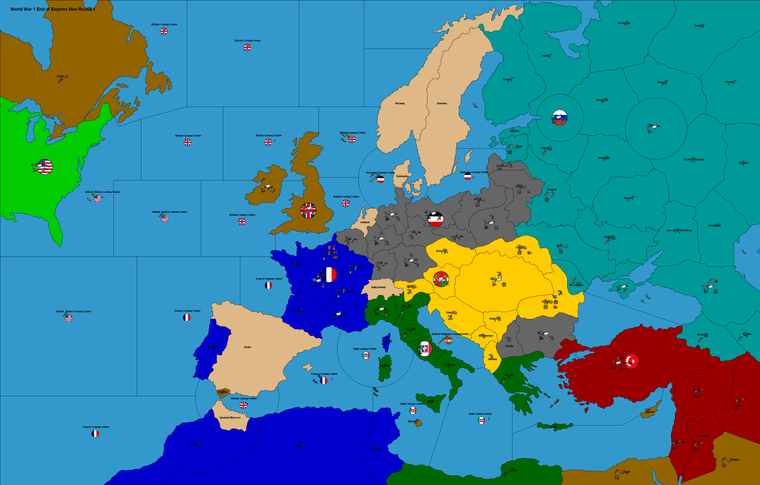
Note that at the start of the game, a lot of territories are already occupied by hostile powers. The territories should revert to their original owner if captured by an allied power; e.g. Lithuania should revert to Russia if captured by Britain (unless Russia has collapsed).
I added a lot of convoy zones and disabled destroyers' anti-stealth capabilities so that German U-boats can cause a lot of damage to the Entente's and especially Britain's income.
A major event I added to the game is the Russian Revolution, which triggers if the Central Powers capture 7 further Russian territories and hold them to the end of the round. Russia becomes neutral and all of their units are removed from the game. The Central Powers get some of their territory in the Treaty of Brest-Litovsk and may move their troops back through Russian territory.
The object of the game for the Entente is to capture Berlin and hold it to the end of the round (Note that I may change this victory condition to be more historical). The object of the game for the Central Powers is to capture Paris and hold it to the end of the round. I was considering making the capture of Rome a victory for the Central Powers, but this might unbalance the game in the Central Powers' favor.
Try the map out and tell me what you think! I tried to make it a fun and balanced game for both sides, so if there is anything you would like added or changed, please tell me.
-
@iratoric I like your starting date as it allows for a traditional all-war yet historical game, but can a realistic WW1 game starting at that point be balanced whilst keeping historical consistency? Is this why the game is called "End of Empires", or are both sides meant to have about the same chance to win?
Based on what you say, I wonder why Russia doesn't have a higher production than Germany as I think this would be given by any WW1 GDP data (of course, at this time, all Russia from the Urals eastward was next to worthless and the territories already occupied by Germany could at most bring it close to parity). Did you do something to the data, like adjusting the GDP by cutting subsistence?
As you can see in the data you linked,
https://warwick.ac.uk/fac/soc/economics/staff/mharrison/papers/ww1toronto2.pdf
Russia (at 264.3) would be alone stronger than Germany (at 244.3).
Of course, both the British Empire (at 561.2) and the United States of America (at 511.6) would be alone over twice as strong as Germany.Are you sure that some simplifications like making Greece a single Italian territory and almost all Anatolia plus Turkish Thrace being a single territory are worth the approximation? About this, I wonder why Portugal is French instead of English. My eyes cannot not fall on the single "Veneto" territory (representing half of northern Italy): it is making impossible to have any historical representation of the war between Italy and Austria-Hugnary as in 1917 the latter destroyed about half of the Italian army while taking less than 20% of what the "Veneto" territory in the game appears to be.
Although I've never played the game, the biggest issue I'm seeing is the fact that Lorraine connects to Alsace and Belgium, whereas Alsace and Belgium are not connected with each other. I think this will cause a weird dinamic in that you cannot move forces to and from Alsace and Belgium by any shortest route without either moving into or moving away from Lorraine. In general, I think having border lines forming a cross (so having four couples of four territories touching each other in only one pixel or such) is weird because the point itself becomes substantially the same as an impassable territory bordering four passable ones. It makes me think to the situation of having a big lake where the point is. Having any two territories touching each other on a single pixel is also something arguably unclear in showing connections, even though it is pretty common in TripleA to consider such territories as non-adjacent, so non-connected.
I agree with the movement 1 for the armour, but the armour is almost worthless a unit. I also agree the fighter should be very weak, but the fighter is very unlikely ever to be purchased. I also agree that the battleship should be way less cost efficient than the submarine, but I think it will never be bought (which can be realistic (and remembers me of Classic), yet it is certainly questionable to offer units nobody is expected ever to buy). About naval units and especially battleships, they should take several years from being laid down to become operative, so, if you are actually making a historical game, it makes no sense that they can be formed in 1 turn, as I guess 1 turn here is representing about 1 month only (so a battleships should take tens of turns to be available).
You should consider making air units unable to target sea units and vice versa, but I know almost nothing about air-to-sea warfare in WW1.
I like your Russian Revolution concept, though Austria-Hungary collapsed with much less of itself being overtaken by the Italians and Germany collapsed (or at least went out of control like in the Kiel mutiny) before anything at all was taken. However, it makes sense for the special rule to be only for Russia, as it was the only major case of losing the war by premature surrender while being on what will be the winning side. I am, however, not sure if it makes sense for the Germans to be able fully to vacate the Russian conquered territories because I imagine they still had to employ some forces in the east even after the Bolsheviks peaced out.
Yeah, probably you should figure out a victory condition for the Entente not requiring actually to get Berlin.
You should not call the powers in the game as "nations". Most of them are not nations: Czechia, Slovakia, Croatia, Bosnia and Hungary are nations; Austria-Hungary is not a nation. It is even doubtful if Austria is a nation (because it can be seen as a portion of the nation of Germany just like the Austrian Littoral is mostly a portion of the nation of Italy). The same goes for Russia, Britain (England and Scotland are nations, not sure about Canada) and the Ottoman Empire.
I would not call "Serbia" as such in the moment it is only a portion of what to which one would correlated the name: you can call it Southern Serbia or Northern Macedonia. Conversely, I would call Dalmatia as Bosnia, Croatia or Austrian Littoral (Österreichisches Küstenland) as each of them were more important than Dalmatia.
-
GDP is insufficient when “war” is taken into account. Because they can be easily skewed or manipulated.
-
Germany is shown as 4.rd strongest country with 1914 borders in here which should have been the strongest. Germany had the the best land and second best naval forces even in 1917.
-
British economy was mostly focused on services(insurance, shipping, foreign investments) while Germany concentrated more on raw industrial production. Another disadvantages of Britain are they had to deal with insurgencies on its colonies and expenese of protecting shipping routes. (They had to invest way more to protect their shipping routes than Germany had to invest to interdict). So the British Empire was definitely weaker than Germany militarily.
-
France and Russia were equal but I think France might be slighly stronger.
-
Turkey should worth at least 2.
-
Italy should be 6 or 7 and Libya should be 0.
-
Russia is way too strong. Its income should be similar to France realistically.
-
USA had almost no army in 1917 even in 1918 it has very small army compared to other major combatants and they had rely on mostly British and French equipments in 1918. Considering war torn European nations it is still questionable for me to make USA even stronger than the British Empire militarily considering the time frame.
My other suggestions;
-
Shrink the smallMap as much as possible to get slimmest right bar.
-
Change the color of USA.
-
Make combat phase before purchase.
-
Change the order of unit purchase list: (Like making infantry, artillery and cavalry first rather aaGun, armour, artillery)
-
Use v3 rule transports.
-
Get rid off the A&A capital rules. (Not losing remaning incomes and mobilizatin abilities if Capitals are lost)
-
Turn Russian units to the left side.
-
Use these better flags:






Bonus if there will be Communists:

-
-
@cernel Thank you for your comments! I wanted to create a balanced game where the Central Powers can knock Russia out of the war without entirely conquering her, then focus on France and capture Paris. It is impractical for the Central Powers to conquer the whole map in this game, but they do not have to in order to win, they only have to get Paris.
For approximating the GDP, I used the 1914 borders (plus some convoy zones to make naval warfare interesting). Germany with her 1914 borders + the 2 convoy zones = 24 PUs, while Russia with her 1914 borders = 25 PUs. Britain does not have her colonies' GDP factored in as they are too far away and are not on the map, and I do not want Britain to be too strong as this would unbalance the game.
You make some good points about the lack of a Belgium/Alsace connection, I can redraw that part of the map so those two territories are connected. I recently redrew a lot of Russia to make it feel like the large country that it is. Portugal can be made English if you like, after all, Britain did request that they confiscate German ships, bringing her into the war.
I am not so sure what to do about Veneto, because I do not want to make it so small that you can not fit units in there. I was considering adding "stalemate" to this game where only one round of combat occurs and the units stay in the territory.
I think the Armour is useful on the attack (not so much on the defense). Maybe pairing it with artillery should boost its attack by one? For fighters I was considering having them give a bonus to artillery, since they can act as spotters for artillery.
For battleships, I agree that they should take longer to place. I will look to see how I can do this in the XML. I know that the United States AI will buy a battleship but Germany AI will usually buy a lot of land units (makes sense).
Germany will typically have to keep a few land units in the conquered Russian lands anyways because Britain will try to naval invade them there if they don't. A resistance to occupation mechanic could be cool but it could also be really annoying. Tell me what you think.
Dalmatia was definitely one of the Italian war aims to capture but calling it Croatia might be more accurate. I will rename the Serbia territory North Macedonia.
-
- If you look at the setup you will see that Germany does have the most land forces and their naval forces are on par with Britain. If you are trying to say that Germany should have a higher production than everyone else, I don't think that they should because then they will demolish France very quickly.
- In this game, Britain's colonies are not included on the map so their industrial production is not added. This could simulate insurgencies in their colonies. Also, a lot of Britain's production is in convoy zones which German submarines can capture. This could simulate the expense of protecting shipping routes.
- Maybe in terms of military skill France was stronger, but Russia had a larger army.
- I may do this, I was considering making the Ottomans a little stronger.
- If Italy is 6 or 7 PUs then they will get trounced by Austria-Hungary. I might move Libya's production into Italy proper, but it does provide some incentive to defend North Africa.
- Russia is not as strong as you think, they will get quickly pushed back by Germany and Austria-Hungary. Plus the Russian Revolution means that the Central Powers can knock them out of the war entirely. Russia's army was larger than France's historically.
- The U.S. Army is tiny at the start if you look at the setup, but after a lot of turns it will become a formidable force. German submarines can slow them down by capturing their convoy centers.
- Thank you for those flags!
I might turn the Russian land units to the left side, but the Russian navy units should face the same direction as the rest of the Entente or you will see a weird effect where the ships are perpendicular to each other. What color do you want USA to be?
-
-
Still making Germany even weaker than Russia (considering 1914 borders) is incredibly unrealistic. Not sure if France would be doomed to fall in this case maybe you could prevent it making the game more defense oriented or giving France some defense specialist units.
-
I'am fairly certain Russia was not stronger than France. Russia was heavily dependent on foreign investments (especially French one) and grain exports (which deprived when the Ottomans joined the war). France was more industrialized, more stable, had better leadership, communication, navy, and innovative capabilities.
-
I mean its fine if you wold prefer to keep Ottomans at 3. But its not realistic giving Anatolia 1.
-
I have no strong preference. Maybe Purple.
-
-
- Germany with 1914 borders has 20 PUs on land and 4 PUs in convoy centers, for a total of 24 PUs. Russia with 1914 borders has 25 PUs. So it is a difference of just 1 PU. However, you do make a good point; a lot of Russia's economy was focused on subsistence farming which could not be converted to military power. Meanwhile, Germany's economy was focused a lot more on the military. As such, I might increase Germany's production by a few PUs.
- It depends on what you mean by "stronger". If you mean industrialization, stability, leadership, etc. then France was definitely stronger. This is reflected in the fact that Russia has a lot of low value territories and it is pretty easy to send Russia into Revolution. However, if we are just talking about raw resources then Russia definitely had more. Technically Russia's army was even larger than Germany's! However, this was mostly an illusion as Russia could not effectively supply all those troops. I was considering making Russia's units have lower attack values but figured it would be offensive, essentially saying that their soldiers are somehow "lesser". So I just gave them fewer units. A better solution might be to add a movement cost to units; I believe the Civil War map did this. That way you would have to supply units to be able to use them.
-
@iratoric About the "players" colours and the colourization of their units, I suggest you take a look at the "Over The Top" map. I wonder why the Austria-Hungary territories and units are yellow? Makes me think it's the Holy Roman Empire. The colours used by the "Over the Top" map are more in line with the colours of the uniforms of the common soldiers at the time, and, pretty much, @GenerationKILL has set some skin standards, with that map, which can hardly be improved by any other World War 1 game, so I'm not saying everyone should just use exactly the same colours, but it is a good point of reference, preferably referring to the displayed territory colours as modified by the map details (not as defined in the "map" properties).
-
Once I had tried realistically rating major WW1 combatants considering, GDP, war making capabilities, steel productions, electric comsuptions, vulnerabilities, stability, leadership etc... I had came up with these numbers;
Germany: 11
Austria: 4
Ottoman: 1British Empire: 9
France: 6
Russia: 6
Italy: 2
If we could take into account the fact that the Central Powers were able to fight against basically the rest of world for 4 years while taking 4 enemy capitals and knocking out of one of major entente member. These ratings seems realistic to me. If Germany was weaker than both the British Empire and Russia in 1914, there is absolutely no way the war could last 4 years, the Central Powers would be decisively defeated within 1 year.
Also some realistic aspects are harder to take into account like Austria's terrain advantage over Italy that's one of the reason why Italy couldn't even advance Austria significantly despite outnumbering Austria 2-2.5 to 1.
-
I have done a fair amount of research on the economics of the world wars, especially with regards to databases, the most useful being the Maddison Database and the Correlates of War. It is surprisingly difficult to relate GDP figures to actual military capacity and production. (There are also quality problems with both databases, such as abrupt, inexplicable changes between adjacent years, and not agreeing with each other).
In both world wars, Germany & Russia had roughly similar GDP's, but in WW1 the Germans beat the Russians in every battle with basically a quarter of their resources, while in WW2 the Russians stopped the Germans when the Germans used most of their resources to fight the Russians. The Russian mobilization was very inefficient in WW1, while German mobilization was somewhat inefficient in WW2.
An interesting example is the Sino-Japanese war of 1937-1945. The GDP's were similar and the Chinese armies were larger (but less well equipped). But a combination of Japanese Air/Naval superiority and Chinese inefficiency meant that Chinese could only fight a defensive war and were unable to hold their major coastal cities.
To really replicate 1917 situation, Russia needs to have minimal offensive power. Russia had basically lost its offensive capability after the ultimate failure of the 1916 Brusilov offensive. (My grandfather, fighting for Austria was captured then). They can have lots of units, but little attack capability. This puts the Germans in their historical dilemma, of committing large forces to conquer Russia or focusing on the West.
Historically, the German leadership, tantalized by the goal of Paris, chose wrong. Had they stood on the defense in 1918 and focused attention on turning Russia into a series of pro-German client states, they probably would have achieved stalemate in the West and a negotiated peace leaving the Germans dominant in Eastern Europe. The limited efforts made to create client states were fairly effective (these countries are still around). An orderly purchase of agricultural products from the Ukraine would have averted the food shortages that sapped German home front morale in 1918.
By the way, Schulz's production values are fairly similar to the ones used by Kirk Uhlmann his excellent game The Lamps are Going Out.
Germany: 12
Austria: 3
Turkey: 1Great Britain: 7
France: 4
Italy: 1
Russia: 4 -
@cernel I do like the color scheme "Over the Top" uses, so I will change the colors and use those instead. The main thing I don't like about that map is that Austria-Hungary looks kind of weird. By map details, are you referring to the map relief? I think the map relief uses a semi-transparent layer which would look better than the opaque colors I am currently using.
I changed the border between Alsace and Belgium so that they are connected now:
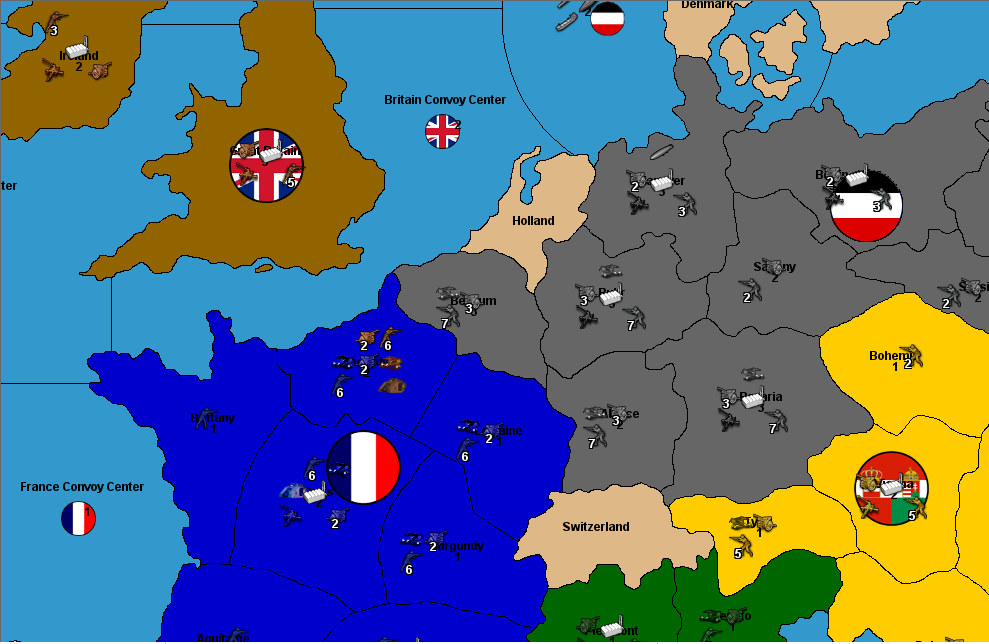
This definitely solidifies Germany's hold on Belgium because they can attack into Belgium from two territories now.@Schulz I let the Hard AI play against itself with the new Belgium-Alsace connection and got this result:
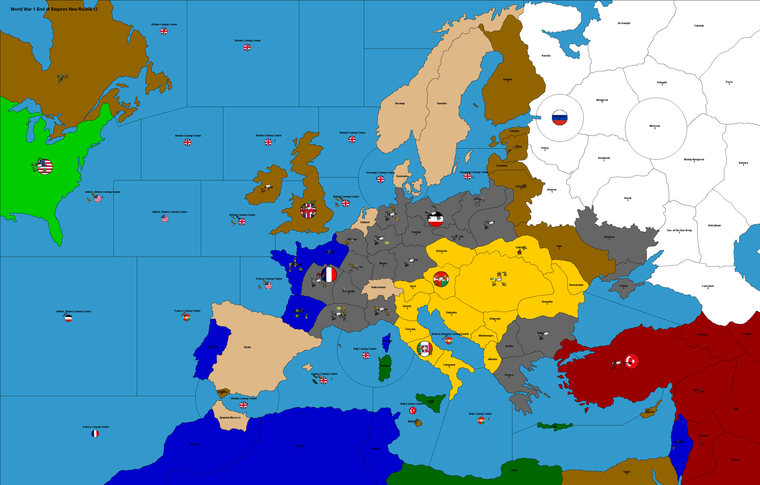
As you can see, the Central Powers took Paris by round 12, winning the game. So it is definitely possible for the Central Powers to win.Here are some tips on how to win as the Central Powers:
- Use your submarines to capture convoy centers
- When warships try to attack your submarines, either submerge or retreat, you will do more damage by attacking convoys
- The Entente as a whole is stronger than the Central Powers so you will have to practice defeat in detail
- Focus on knocking Russia out of the war first, defend against France and Italy
- When Russia makes peace, you will get a boost to your income from the conquered lands
- Use your navy to prevent Britain from naval invading you, plus a few troops along the coastline
- Move your units to the west and defeat Italy and France
- If you can hold Paris to the end of the round you will win
-
@iratoric I didn't mean to discuss the game balance since I haven't played the map yet. I had just intented to share my realistic ratings of nations but all off them are negligible of course.
I have different approach for colors of nations. I think it is wiser to prioritizing distinctive colour rather than using their uniform colours (it is problematic because there will be 3 brown, 2 green and 2 blue nations). For example Russian uniforms obviously weren't red in WWII (neither German ones were pure grey) but red matchs just perfectly for Russia and creates more contrast.
There is of course no historical reason to use yellow for Austria I guess it is used because yellow is one of the primary colour and has to be used somewhere. But I can say I don't like the this shade of yellow. Too bright for me I would suggest to make it slighly more orange-ish if you want to keep it yellow.
You could maybe like my Japan's colour.
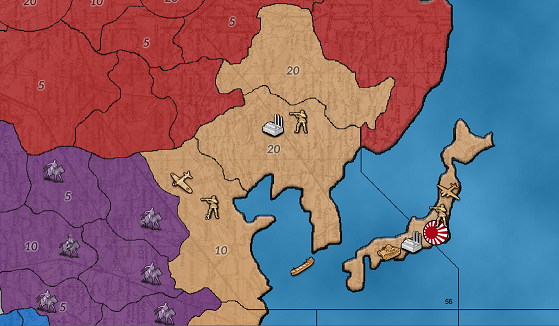
-
@schulz
The only problem with using your Japan color is it looks close to the Impassable color used for Switzerland, Denmark, etc. I do like your suggestion that Austria-Hungary be orange-yellow, so I decided to test it out:

I think this looks much better! Tell me what you think. -
Yes it is better now. (though I would still suggest to making it orange-ish, you could check NAP FFA 8 players and see the Swedish color. It is really distinguishable colour.)
Also I would advice adding a bit grey-ish tone to Russian pure white when they left the war. I've used this color for impassables.
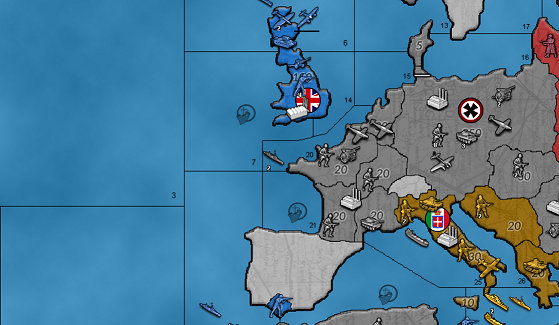
-
@schulz
I changed neutral Russia's color to light grey, now they look like this:
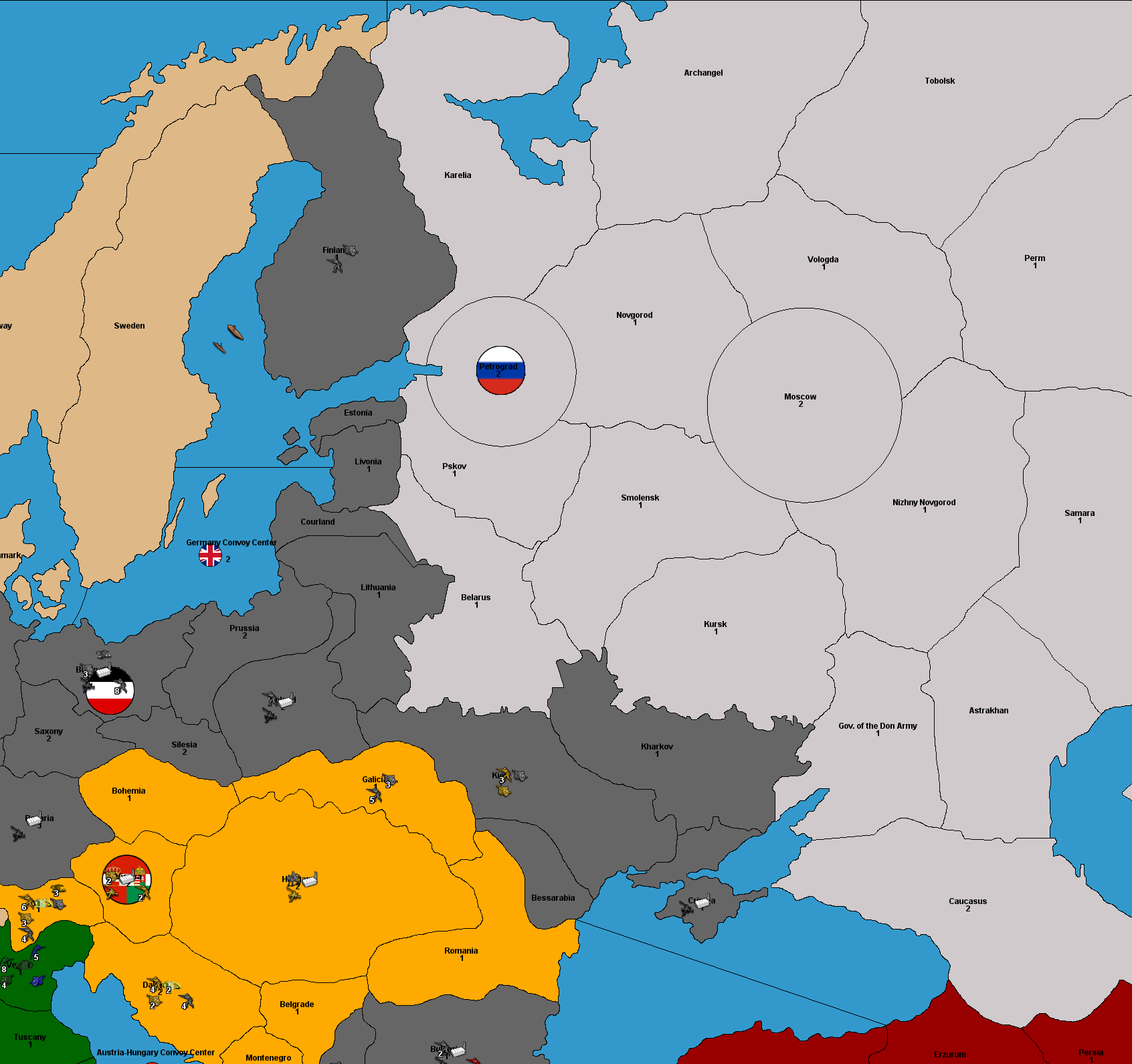
With the current mechanic Russia becomes neutral but not impassable, so German units do not get "stuck" in neutral territory and are able to exit Russia. -
@Schulz
By the way, I was considering giving Belarus to Germany, however it seems that this territory may have remained Russian under the treaty of Brest-Litovsk. -
@iratoric I think the most questionable ownership on the map is Greece being Italian. Of course, a game has to make approximations, and it may also be good to do so, yet, also on the account that the game aims at realism to some extent, I mostly wonder if Italy is the best choice amongst all existent players (instead of, say, France).
About this, Bulgaria is certainly a player one may consider worth (or not worth) being a player, maybe more so than Greece.
Anyways, I also support your general approach to keep the complexity of the game fairly low. You are quite exceptional here (as most map-makers make big and complex games).
-
Congress Poland and Baltics were the only areas which the Germans were able to establish client states hence turning them Grey is correct when Russia left the war.
Ukraine became independent state but had grain agreement with Germany and Austria in exchange of military protection from the Bolsheviks. Belarus was in similar situation. If Ukraine becomes German, then Beularus could be too.
Finland became independent not a client state.
Southern Caucasus was very complicated.
-
@schulz German troops took Helsinki in March 1918. I think we can count Finland as another German client state.
-
@rogercooper I've though because the Germans considered the actions of red Finns backed by the Bolsheviks is a violation of Brest-Litovsk.
I'am not sure if it would be correct to turn Finland grey just because German troops stationed there. As far as I know Finland wasn't a client state (please correct me if there are evidences against this.)